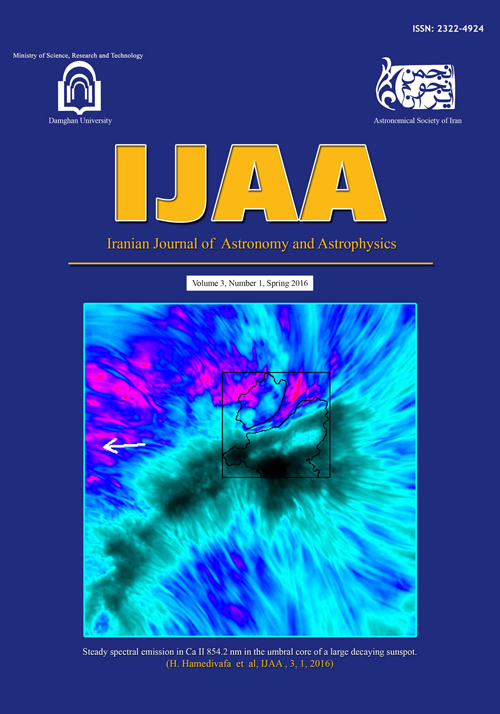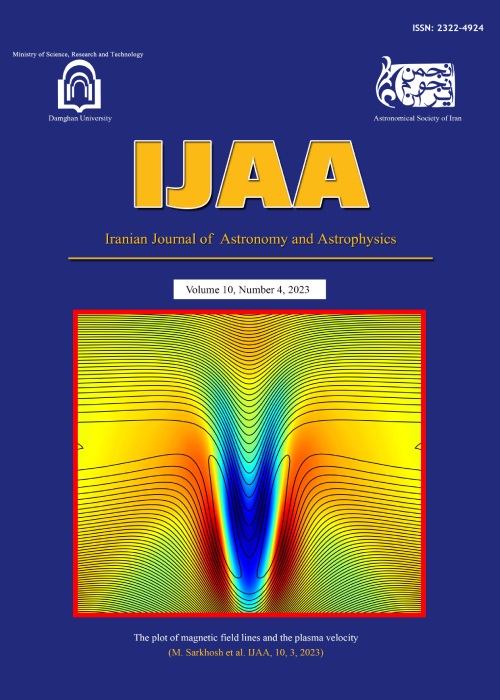فهرست مطالب

Iranian Journal of Astronomy and Astrophysic
Volume:3 Issue: 2, Autumn 2016
- تاریخ انتشار: 1396/02/26
- تعداد عناوین: 6
-
-
Pages 73-80In the present work, we have obtained the equation of state for neutron star matter considering the in uence of the ferromagnetic and antiferromagnetic spin state. We have also investigated the structure of neutron stars. According to our results, the spin asymmetry sti ens the equation of state and leads to high mass for the neutron star.Keywords: Neutron stars, Spin asymmetry, Equation of state
-
Pages 81-106We investigate the growth of matter density perturbations as well as the generalized second law (GSL) of thermodynamics in the framework of f(R)-gravity. We consider a spatially flat FRW universe filled with the pressureless matter and radiation which is enclosed by the dynamical apparent horizon with the Hawking temperature. For some viable f(R) models containing the Starobinsky, Hu-Sawicki, Exponential, Tsujikawa and AB models, we first explore numerically the evolution of some cosmo-logical parameters like the Hubble parameter, the Ricci scalar, the deceleration param-eter, the density parameters and the equation of state parameters. Then, we examine the validity of GSL and obtain the growth factor of structure formation. We find that for the aforementioned models, the GSL is satisfied from the early times to the present epoch. But in the farther future, the GSL for all models is violated. Our numerical results also show that for all models, the growth factor for larger structures, like the ΛCDM model, fit the data very well.Keywords: Modied theories of gravity, Dark Energy
-
Pages 107-119In the current paper, we have studied the effect of dark energy on for-mation where dark energy exists in the background. For this purpose, we used both WMAP9 and Planck data to study how the radius changes with redshift in these mod-els. We used different data sets to fix the cosmological parameters to obtain a solution for a spherical region under collapse. The mechanism of structure formation for dark and baryonic matter is different. When processed by gravitational instability, den-sity perturbations have given rise to collapsed dark matter structures, called halos. These dark matter halos offer the backdrop for the subsequent formation of all col-lapsed baryonic structures, including stars, galaxies, and galaxy clusters. In Planck Data forΛCDM, with the presence of dark energy in the background, the formation of baryonic matter is delayed. Therefore, it is a factor for the largening of the baryonic matter radius. Accompanying dark energy is entailing an increment of dark matter virial radius. For WACDM Data, dark energy alongside time-dependent parameter of state and baryon acoustic oscillations are the reasons for the delay of dark matter formation and the radius reduction. Due to the lack of data without baryonic acoustic waves in the background, we are left unable to delineate its impact on the structures. In WCDM(BAO ) and WCDM(H0), the lack of BAO shows a critical role in the delaying of baryonic matter structure formation. Respectively, it causes growing virial radius of dark matter. BAO, without taking dark energy into accounts, is the reason for the increasing and decresing of radius of dark and baryonic matter. It also delays baryonic matter formation. In ΛCDM(BAO ) and ΛCDM(H0), We have studied ΛCDM data for standard model under two circumstances: (a) ΛCDM(BAO H0),(b) ΛCDM(H0) data. Dark energy in this data delays formation and intensifies virial radius of baryonic matter. Our studies show WCDM andΛCDM have the same effect on formation if we do not consider dark energy in BG. Planck data, in comparing with WMAP, has important role in describing standard model.Keywords: Dark Energy, Scalar Fields, Baryonic Acoustic Waves, Standard Model
-
Pages 121-132Today, great observatories around the world, devote a substantial amount of observing time to sky surveys. The resulted images are inputs of source finder modules. These modules search for the target objects and provide us with source catalogues. We sought to quantify the ability of detection tools in recovering faint galaxies regularly encountered in deep surveys. Our approach was based on completeness estimation in magnitude - size plane. The adopted method was incorporating artificial galaxies. We improvised a software that estimates completeness in a given interval of magnitude and size. The software generates artificial galaxies and iteratively inserts them to the source finder modules input image. Evaluating the ratio of the number of detected to the number of inserted artificial galaxies provides us with means to estimate completeness. Completeness estimation is helpful in selecting unbiased samples.Keywords: Galaxies: structure, galaxies: size, magnitude
-
Pages 133-150In this paper, a combination of the braneworld scenario and covariant de Rham-Gabadadze-Tolley (dRGT) massive Gravity theory is proposed. In this setup, the five-dimensional bulk graviton is considered to be massive. The five dimensional nonlinear ghost-free massive gravity theory affects the 3-brane dynamics and the gravitational potential on the brane. Following the solutions with spherical symmetry on the brane, the full field equations together with the generalized Israel-Darmois junction conditions on the brane and their weak field limits are presented in details. Generally, the theory has four Stuckelberg fields along with the components of physical metric. Although analytical solutions of these equations are impossible in general, by considering some simplifying assumptions, two classes of four-dimensional spherically symmetric solutions on the brane with different background Stuckelberg fields are obtained.Keywords: Braneworld Gravity, Massive Gravity, Black Holes
-
Simulation Calibration of an Extensive Air Shower array, by a logged data set of its small prototypePages 149-158Magnetic fields play an important role in creating, driving, and in the evolution of outflows and jets from protostars and accretion disks. On the other hand, the temperature profile of the accretion disks may also affect the structure of the magnetic field and outflows. In this paper, we use the self-similar method in cylindrical coordinates to investigate the effect of the temperature profile of the accretion disk (T ∝r-1/2) in the formation of jets and outflows around protostars. The results show that in each specified angular momentum, there is a critical value for the ratio of the mass flux to the magnetic flux. For values less/larger than this critical value, taking into account the temperature profile in the disk results in a broadening/collimation of the jet, respectively. Outflows, on the other hand, are always broadened when accounting for the temperature profile of the disk.Keywords: accretion discs, magnetic fields, (magnetohydrodynamics) MHD, methods: numerical, stars: protostars, ISM: jets, outflows


